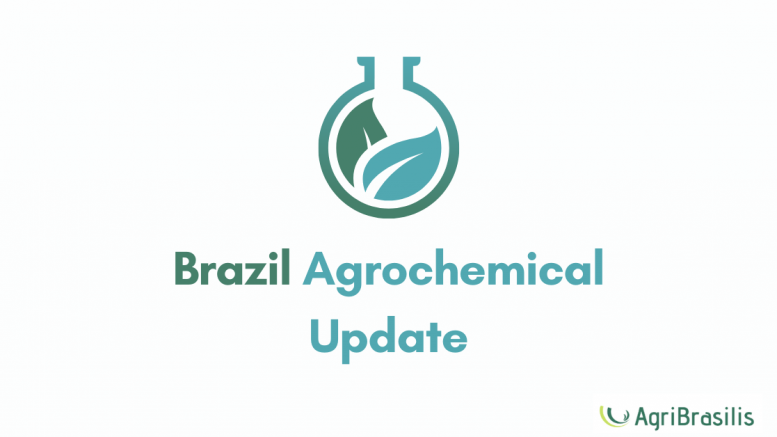55 new pesticide registrations of formulated products, including 15 for organic agriculture
Recovered a 60 tonnes fertilizer cargo estimated at US$ 112.2 thousand, diverted from the Port of Capuaba, in Vila Velha, State of Espírito Santo. Cargo was recovered by the Civil Police in the city of Guarapari, Espírito Santo. Police suspects the participation of employees from the Port in the theft of the fertilizers. (Civil Police; Guarapari Regional Police Station)
Another 38 municipalities in the State of Rio Grande do Sul should comply with new rules for the purchase and use of hormonal pesticides. Changes include the requirement of qualification for applicators and the need to declare the use of herbicides, and are included in the determinations of Normative Instructions 12 and 13 of the Secretariat of Agriculture, Livestock and Rural Development, that bring new guidelines about the risk mitigation work for hormonal pesticide drift in farms. (Seapdr-RS)
Approximately 625 tonnes of organic fertilizer are being distributed to farmers in the city of Brasília to encourage income generation in the countryside and promote the productive inclusion of the rural population. Action is carried out by the Secretariat of Agriculture and started focused on agrarian reform settlers, but will also be extended to other family farmers. (Seagri)
Orígeo, an agricultural advisory company that also deals with the direct sales of inputs, created by Bunge and UPL in June 2022, starts their first operation expansion, working in the State of Mato Grosso. The beginning of the operations in the state is scheduled for April 2023. “We are assisting 350 groups (farmers or agricultural production companies) and the next step is the expansion to the State of Mato Grosso, where we will include 650 groups, reaching a thousand”. (Orígeo)

Vice-president Geraldo Alckmin said to Bayer’s global CEO, Werner Baumann, that the new government plans to reduce the time required to register patents at the National Institute of Industrial Property (INPI) to less than half. Registering a patent takes an average of four years in Brazil. (Ministry of Development, Industry and Commerce)
Through Ordinance No. 737, MAPA submits to public consultation, for 60 days, the proposal for a Joint Ordinance between MAPA, Ibama and Anvisa, that aims to establish procedures for the distribution of pending pesticide registration processes of equivalent technical product, pre-mixtures and formulated product categories, filed before 10/07/21, seeking to comply with the Decree No. 10833/2021. Proposal seeks to optimize registration
After reaching record values in early 2022, fertilizer prices are going back to levels from before the Russia-Ukraine conflict, as a result of lower demand. Perspectives are more favorable for 2023. “Supply should recover and demand will be cautious, not accepting high levels. Thus, prices should retreat and be lower than in 2022. Even so, prices should remain above the average of recent years “, according to Maisa Romanello, consultant at Safras & Mercados. (Radar Agro, Itaú; Safras & Mercados)
Approved a record number of low-impact crop protection product registrations in 2022. “This year, 136 new low-impact formulated products were registered. Among them there are 79 products authorized for use in organic agriculture,” said the Ministry of Agriculture’s deputy general coordinator for pesticides, Marina Dourado. (Ministry of Agriculture)

Ministry of Agriculture approves 55 new pesticide registrations of formulated products, including 15 for organic agriculture and 27 classified as slightly dangerous to the environment; and approval of the herbicide containing the new active ingredient thiafenacil. (Ministry of Agriculture)
Biofertilizer can reduce fruit drop caused by greening (disease caused by Candidatus Liberibacter spp.) in citriculture. A new type of fertilizer with bactericidal potential is the result of research carried out for more than 20 years at the Instituto Agronômico de Campinas and contains the antioxidant molecule N-acetylcysteine. (IAC)
AllierBrasil Consulting launches an online platform that allows the search of pesticide registrations and information on the status of pesticide registration processes in partnership with AgiBrasilis. Data on registration of formulated products, canceled registration requests and suspended registrations are now available. (AllierBrasil; AgriBrasilis)
Copasa inaugurates its first research unit for the production of class B organic compound fertilizer from sludge generated in sewage treatment plants, mixed with materials left over from plant pruning, in Belo Horizonte, State of Minas Gerais. Initiative is the result of a partnership for research, technological development and innovation established between Copasa and the company TreeCompost in June of 2022. (Copasa; TreeCompost)
Manuchar, a chemical products distributor based in Antwerp, Belgium, signed an agreement to acquire Plury Química, an importer and distributor of additives, ingredients and other chemical products for the food and industrial market, including for the plant nutrition sector. Value was not disclosed. (Manuchar; Plury Química)

READ MORE:

